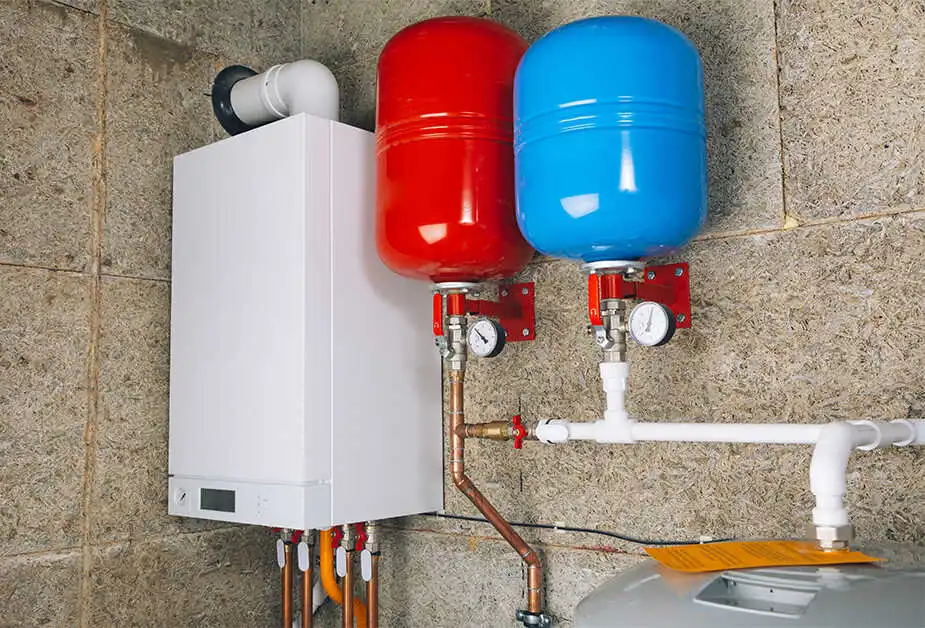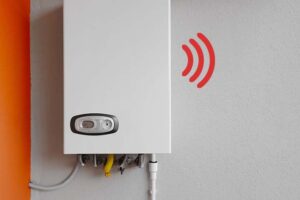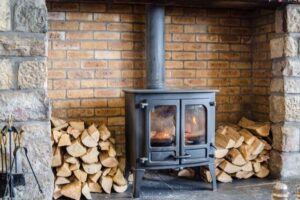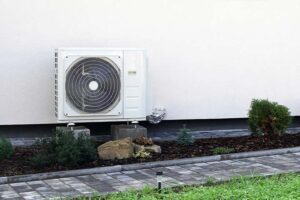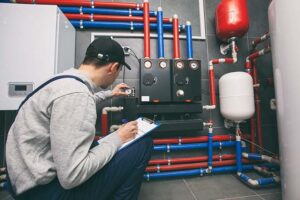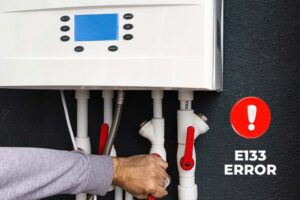|
Key Highlights |
|
In the winter, our homes need gas boilers to stay warm. They heat water and send it around the house to keep it warm. Some people might not understand what does boiler pump overrun means or how important it is for a gas boiler to work properly. This blog will talk about boiler pump overrun, how it works, and why your boiler needs to be as efficient as possible.
A thermostat, timer, or pump circuit board that is broken could make the boiler pump overrun for a long time. If your boiler is having these kinds of problems, you should get it fixed by a Gas Safe-certified expert. Do-it-yourself fixes could put your health and house at risk. Professionals can figure out what’s wrong and fix it safely.
What Does Pump Overrun Means
Pump overrun is a normal function in boilers that allows the pump to continue running briefly after the heating or hot water has been used. Its purpose is to dissipate any remaining heat in the system, preventing potential damage to the boiler’s components. Pump overrun typically lasts around 5 to 10 minutes and is controlled by either a thermostat or a timer.
Not all boilers require pump overrun, as some larger boilers can handle the residual heat without this feature. If the pump overrun lasts excessively or runs continuously, it could indicate a problem with the system that requires
Common Signs Your Boiler’s Pump Overrun Is in Action
You need to know how to spot boiler pump overflow signs to keep your heating system in good shape. One sign is that the central heating pump is still running after the water or heat has been used. This means that the overflowing pump is spreading the heat around the system. Another sign is a loud buzzing sound coming from your boiler box.
Most of the time, this noise is caused by a pump overflow. You may also notice that the setting for the heat or hot water stays on after the boiler is turned off. These signs show that the pump is overloaded, which lets the heat out and keeps boiler parts from breaking. If you notice any problems or a lot of pump overflow activity, you should call a trained tech to look at it and fix it.
Preparing for Pump Overrun: What You Need to Know
Learn how to get your boiler ready for pump overflow before we get into the specifics. Bypass valves are often built into system and combo stoves. This valve lets hot water flow through the system to cool it down when the pump runs too fast. A qualified professional should check your boiler regularly to make sure that all of its parts, including the pump overrun, are working properly. Call a qualified expert instead of trying to fix things yourself.
Essential Tools and Resources for Managing Pump Overrun
To effectively manage boiler pump overrun in your heating system, there are several tools and resources that can be helpful. These include:
- Timer
- Pump Circuit Board (PCB)
- Automatic Bypass Valve
- Thermostat
- The pump overrun function in your heating system will work best if you use these tools and resources, do regular upkeep, and get help from a professional.
Identifying Your Boiler Type and Pump Overrun Compatibility
You need to know what kind of boiler you have in order to decide if pump overrun is needed and will work with it. There are three main types of boilers: normal, combo, and system.
Check the manufacturer’s specifications or talk to a trained professional to find out what the pump overrun needs and if it will work with your boiler.
Assessing Pump Overrun Functionality
Follow these steps to check the pump overflow in your heating system:
Step 1: Locating Your Boiler’s Pump Overrun Settings
To find out how well your boiler works in your heating system, you need to find its pump overrun settings. To get to the settings, do the following:
- Read the user manual: The manual that came with your boiler should tell you how to use the pump overrun settings.
- Contact the Manufacturer: If the user manual doesn’t have the information you need or you can’t figure out how to change the settings, call the maker.
- Check the Boiler Control Panel: There may be options for pump overflow on the boiler control panel. Look for keys that say “pump overrun” on the control panel.
- Next, check to see how the pump overruns on your boiler after each heating cycle. Once you have found the pump overrun settings, move on.
Step 2: Monitoring Your Boiler After Heating Cycles
Once you know how to set your boiler’s pump overrun, you should check it after each heating cycle. Do these things:
- Use the Heating System: Once you turn it on, wait for it to reach the right temperature. Right now is the time to check the central heating pump.
- Switch Off the Heating: Once you’ve hit the temperature you want, turn off the heat. Check to see if the heat pump runs for a while.
- Note the Duration: Take note of the duration for which the central heating pump runs after the heating system is switched off. This duration indicates the pump overrun functionality of your boiler.
- If you see any problems or a lot of pump overflow activity, you should call a trained tech to look at it and fix it.
Practical Solutions and Fixes
Problems with pump overflow in your boiler need to be fixed to keep it working well and stop more damage from happening. Take a look at these changes and answers:
Adjusting Settings for Optimal Pump Overrun Performance
For your heating system’s pump overrun to work at its best, you need to change the settings. Remember these important things:
- Motorised Valves: Make sure that the motorised valves in your system work properly and that the pump overflows.
- Bypass Radiator: Make sure that your bypass radiator is set up correctly and is working. This helps keep the flow of hot water steady when the pump gets too strong.
- Zone Valves: Set zone valves to keep the pump from running too long and to make sure heat is spread evenly.
- If you change these settings correctly, the heat will be removed and the pump will work well during an overrun.
When to Seek Professional Help for Pump Overrun Issues
If your heating system pump overruns, you should call a licensed professional. If any of these things happen, you should get professional help:
- Damaged PCB: If a damaged Pump Circuit Board (PCB) causes the pump to overrun, you should get it fixed or replaced by a professional. It could be dangerous to fix the PCB yourself.
- Costly Damage: If problems with pump overflow hurt other parts of the heating system or need major fixes, you should get help from an expert. Engineers who are registered can find and fix problems correctly.
- Faulty Thermostat or Timer: If a broken thermostat or timer is causing problems with pump overrun, you should get it checked out and fixed by an expert. They might check the settings and fix anything that is broken.
- Repairs for pump overruns can be done safely and properly with the help of a professional. This will keep the heating system working well and avoid further damage.

The Impact of Pump Overrun on Boiler Efficiency and Longevity
Overflowing pumps shorten the life and performance of boilers by a lot. By running the pump longer after the heating or hot water is used up, pump overflow keeps heat from going to waste. This means that less energy is saved, electricity bills go down, and the environment is hurt. Overrunning the pump stops the boiler from rotating, which could damage boiler parts and cause breakdowns. Maintaining the temperature of the heating system with pump overrun makes the boiler last longer.
How Pump Overrun Contributes to Energy Savings
If you want to save energy in your heating system, you need to think about pump overflow. Overflowing the pump keeps heat from being lost by running the pump after the boiler has shut down. Less energy is used to heat water and in the living rooms, so less money is spent on energy. Overflowing pumps stop the boiler from moving, which loses energy. By preventing boiler cycle, pump overrun keeps the heating system’s temperature steady, which saves energy and makes it more efficient.
The Role of boiler Pump Overrun in Preventing Wear and Tear
Overflowing pumps keep boilers and parts from wearing out. To keep the temperature steady, a boiler turns on and off. Cycling the boiler too often may put stress on its parts, shortening their life and leading to problems. By moving leftover heat around the heating system, boiler pump overrun helps keep the temperature stable and stops the boiler from rotating. This keeps the boiler from rotating as much, which makes it last longer and be more reliable. Pump overflow lowers the stress and wear on boiler parts, which makes the heating system last longer.
Navigating Common Challenges with Boiler Pump Overrun
Pump overrun on boilers is normal, but it can be a problem. The following boiler pump overrun problems can happen to homeowners:
- Troubleshooting Persistent Pump Overrun Activity: If the pump overflows often, there may be a problem with the whole system. The reason for this action could help you figure out what’s wrong and fix it.
- Overcoming Obstacles with Older Boiler Models: Older boiler models might need extra parts or not have a pump overflow. These problems can be fixed by adding a bypass valve or upgrading the pump.
- Homeowners can make sure their heating systems work well and efficiently by using careful navigation and the right resolution.
Conclusion
To maintain heating systems, you need to know about boiler pump overflow. Finding warning signs, getting supplies, and following clear instructions will help you get the most out of your pump overflow. Performance and lifespan can be increased by changing settings and getting professional help.
Long-term benefits of a boiler include less wear and tear and lower energy costs due to pump overload. You can understand and fix boiler pump overrun problems by troubleshooting and answering frequently asked questions (FAQs). Being proactive and knowledgeable will help you keep your boiler working well and make it last longer.


